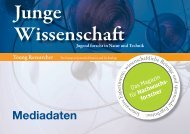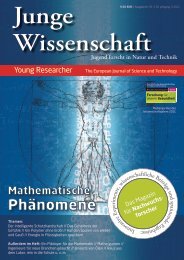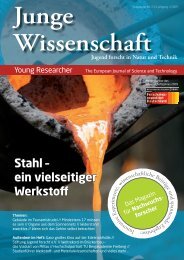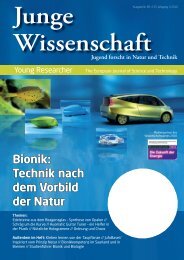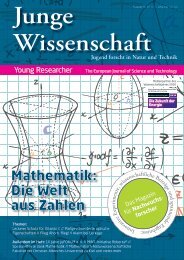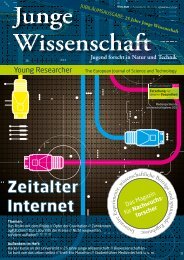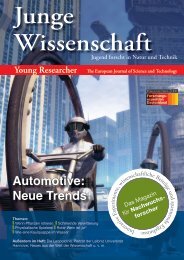2008: Das Jahr der Mathematik - Junge Wissenschaft
2008: Das Jahr der Mathematik - Junge Wissenschaft
2008: Das Jahr der Mathematik - Junge Wissenschaft
Create successful ePaper yourself
Turn your PDF publications into a flip-book with our unique Google optimized e-Paper software.
Jugend forscht<br />
Jugend forscht<br />
visual information such that any given<br />
neuron only responds to a subset of stimuli<br />
in its receptive field.<br />
Recognizing an object in the human brain<br />
takes only a fraction of a second. The neural<br />
mechanisms un<strong>der</strong>lying this remarkable<br />
ability are not well un<strong>der</strong>stood. Until the<br />
mid-1990s, little was known about the functional<br />
organization of human visual cortex.<br />
This landscape has changed dramatically with<br />
the invention of functional magnetic resonance<br />
imaging (fMRI), a powerful tool for<br />
the noninvasive mapping of the normal human<br />
brain.<br />
Recent studies have shown that there are<br />
regions in the cortex which specialize in specific<br />
visual stimuli recognition. Using fMRI<br />
techniques, Malach and colleagues delineated<br />
an area that showed a preferential activation<br />
to images of objects, compared to a wide range<br />
of texture patterns [9]. This area was termed<br />
the lateral occipital cortex (LOC).<br />
Kanwisher and co-workers have suggested<br />
that this area and some other regions located<br />
at the ventral temporal cortex, contain a limited<br />
number of modules specialized in specific<br />
category recognition such as faces (fusiform<br />
face area; FFA), places (parahippocampal<br />
area; PPA), and body parts (extrastriate body<br />
part area; EBA). ([6]; [10], [11].<br />
Vision is the most dominant sensory modality<br />
of primates. The visual system is almost<br />
constantly exposed to new images and thus<br />
it is forced to adjust the visual coding to the<br />
characteristics of the image currently presented.<br />
Visual adaptation is a known phenomenon<br />
induced when the visual system is<br />
exposed to the same stimulus for a prolonged<br />
time. Processes of visual adaptation manipulate<br />
the sensitivity of the cells in the visual<br />
cortex. Exposure to an adapting pattern for<br />
several seconds causes a decrease in the sensitivity<br />
of neurons tuned to the pattern’s specific<br />
properties. This phenomenon lasts a few<br />
more seconds after the stimulus is turned off,<br />
and thus defines the adaptation effect. In that<br />
period the exposed subject recalls striking<br />
changes in the perception of shape, color<br />
and motion. Adaptation involves a variety of<br />
visual attributes and stages of visual processing.<br />
why our perception is briefly perturbed.<br />
Very little is known though about short-term<br />
adaptation.<br />
Our project is divided in two parts: we intend<br />
to contribute to a better un<strong>der</strong>standing of<br />
short-term adaptation mechanisms in – on the<br />
one side – primary visual areas and – on the<br />
other side – in high or<strong>der</strong> face-related visual<br />
areas. As we can see clearly, there is a hot debate<br />
on the neural mechanisms that are fundamental<br />
to face perception and yet, a major<br />
consensus regarding cortical areas that are<br />
most activated by viewing faces.<br />
We, therefore, used 2D geometrical shapes<br />
with grayscale grating pattern and 2D<br />
grayscale face images as the most captivating<br />
and tuned stimuli. Our main assumption was<br />
that short-term adaptation affects the ability<br />
to receive and analyze new coming stimuli. In<br />
or<strong>der</strong> to prove it, we conducted a psychophysical<br />
experiment testing the impact of<br />
short-term adaptation on subjects' ability to<br />
distinguish changes in contrast and figural<br />
properties of a stimulus.<br />
2 Methods<br />
Two psychophysical experiments were conducted<br />
which were aimed to find out the influence<br />
of short-term adaptation on the ability<br />
to note minor changes in the presented<br />
stimuli. It is important to note that without<br />
adaptation those modifications could be easily<br />
detected. The experiments were conducted<br />
serially as the or<strong>der</strong> was controlled.<br />
2.1 Participants<br />
Twenty subjects (eight males and twelve<br />
females) participated in the experiment, five<br />
of them were eliminated (two males and three<br />
females) due to some environmental factors<br />
while conducting the experiment. All of them<br />
were students at the age of 16 - 33 years. All<br />
were regular users of computers and had normal<br />
or corrected-to-normal vision. Except for<br />
one, all the subjects were right-handed. The<br />
amount of sleeping hours during the night<br />
before the experiment varied between 4 - 9<br />
hours. Three of them have participated in psychophysical<br />
experiments before.<br />
2.2 Stimuli of the experiment on primary<br />
visual areas<br />
To examine the effect of short-term adaptation<br />
in primary visual areas, stimuli were chosen<br />
which most activate the primary visual cortex<br />
(Experiment A). While constructing our<br />
experiment we used motives resembling to<br />
those found in previous research dealing with<br />
long-term adaptation. These kinds of stimuli<br />
are proved to activate mainly primary areas in<br />
visual cortex. We used four different 2D geometrical<br />
shapes with grayscale grating pattern;<br />
each had four different types of modification<br />
(Fig. 1): the original image, same image with<br />
modified spatial frequency (figural modification),<br />
both with original and different level of<br />
contrast (contrast modification). All modified<br />
parameters were controlled such that in each<br />
image the modification level is comparable to<br />
the other.<br />
2.3 Stimuli of the experiment on highor<strong>der</strong><br />
visual areas<br />
As our second aim was to examine the effect of<br />
Long-term visual adaptation and its effects<br />
have been extensively studied for many years.<br />
It is known that due to adaptation, our brain<br />
is forced to bias any new information to<br />
alternative non-adapted neurons which is<br />
Figure 1: Experiment A: Bottom row-original images, upper row-different modifications a) no modifications,<br />
presenting the same image again. b) spatial frequency modification. c) contrast modification.<br />
d) a combined modification of both contrast and spatial frequency<br />
Young Researcher 33



